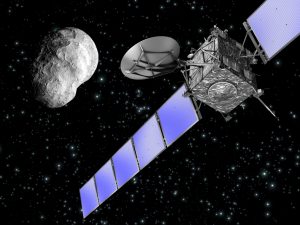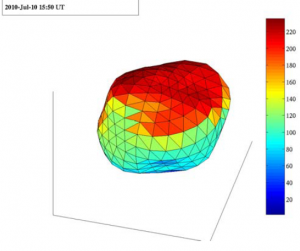
On 10th July, the Rosetta spacecraft will pass by the asteroid Lutetia at a distance of a mere 3162km. It will study the asteroid’s surface, dust environment, exosphere, magnetic field, mass and density. Because Rosetta is speeding past at 15km/s – on its way to a 2014 encounter with comet Churyumov-Gerasimenko – it will only get a quick snapshop of the asteroid.
Closer to home, but some 450 million km from Lutetia, Herschel will be observing the same asteroid. By staring continuously at Lutetia for several hours before the encounter, Herschel will be able to construct a map of the comet’s surface. Because the asteroid is constantly spinnin on its axis once every 8 hours or so, Herschel can image the different faces. The PACS spectrometer will allow Herschel astronomers to not only tell which areas of the asteroid are brighter, but will also provide key information about the composition. Around sixteen hours after the flyby, the SPIRE instrument will observe in the sub-mm, imaging the same face that Rosetta will have seen as it whizzed past.

“This will be the ‘jewel in the crown’ of our data set, as it will not only give us an overview of the makeup of this asteroid, it will also – with a great deal of processing work – allow us to identify specific mineralogical features and compare these to what Rosetta will observe,” says Laurence O’Rourke, principle investigator of the MACH-8 Programme at the Herschel Science Centre at ESAC.
Asteroids and comets are very useful objects to observe, as they provide clues about the formation of the Solar System and how the planets, such as Earth, formed. Goran Pillbratt, Herschel Project Scientist, said “Herschel will observe a number of asteroids over its life. To be able to compare results with in-situ observations for some of them will enhance the value of all observations for all parties. This is a win-win situation for everyone.“
The MACH-8 (Measurements of 8 in-situ observed Asteroids & Comets with Herschel) team are a group of scientists, led by members of the Herschel Science Center. They will use Herschel to observe two comets and six asteroids which have been, or will be, visited by spacecraft. As well as Lutetia, Herschel will also observe the asteroid Steins, which Rosetta visited in 2008, and the comet-chaser’s final destination, Comet Churyumov-Gerasimenko.
For more information, see the Rosetta Blog.
